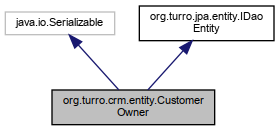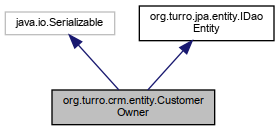- Author
- llturro
Definition at line 12 of file CustomerOwner.java.
◆ entityId()
| Object org.turro.crm.entity.CustomerOwner.entityId |
( |
| ) |
|
◆ getAlert()
| Formula org.turro.crm.entity.CustomerOwner.getAlert |
( |
| ) |
|
◆ getComission()
| Formula org.turro.crm.entity.CustomerOwner.getComission |
( |
| ) |
|
◆ getCustomer()
| Customer org.turro.crm.entity.CustomerOwner.getCustomer |
( |
| ) |
|
◆ getId()
| long org.turro.crm.entity.CustomerOwner.getId |
( |
| ) |
|
◆ getOwningDate()
| Date org.turro.crm.entity.CustomerOwner.getOwningDate |
( |
| ) |
|
◆ getVendor()
| Vendor org.turro.crm.entity.CustomerOwner.getVendor |
( |
| ) |
|
◆ isEmpty()
| boolean org.turro.crm.entity.CustomerOwner.isEmpty |
( |
| ) |
|
◆ setAlert()
| void org.turro.crm.entity.CustomerOwner.setAlert |
( |
Formula |
alert | ) |
|
◆ setComission()
| void org.turro.crm.entity.CustomerOwner.setComission |
( |
Formula |
comission | ) |
|
◆ setCustomer()
| void org.turro.crm.entity.CustomerOwner.setCustomer |
( |
Customer |
customer | ) |
|
◆ setId()
| void org.turro.crm.entity.CustomerOwner.setId |
( |
long |
id | ) |
|
◆ setOwningDate()
| void org.turro.crm.entity.CustomerOwner.setOwningDate |
( |
Date |
owningDate | ) |
|
◆ setVendor()
| void org.turro.crm.entity.CustomerOwner.setVendor |
( |
Vendor |
vendor | ) |
|
The documentation for this class was generated from the following file:


 Public Member Functions inherited from org.turro.jpa.entity.IDaoEntity
Public Member Functions inherited from org.turro.jpa.entity.IDaoEntity